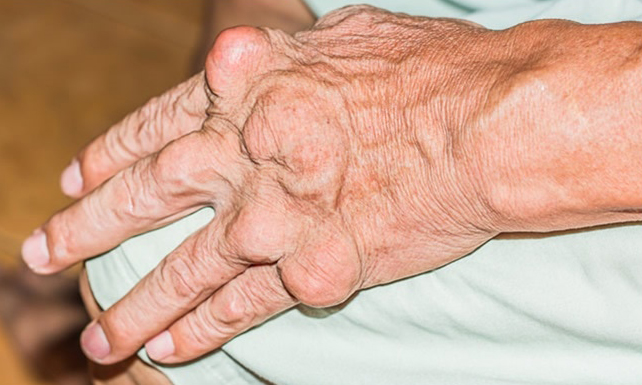
Cause:
Some patients who have high levels of uric acid in the blood develop gout. (About 5-15%,depending on the level of uric acid). Uric acid enters the joint and crystals (picture above) deposit in the joint and causes intense inflammation causing redness,pain and swelling of not just the joint but the whole area around the joint (mimicking skin infection:cellulitis). This “joint attack” is called gout. Even simple touch is painful. Low to high grade fevers may accompany the joint pain. Usually only one joint (typical the base of the big toe) is involved. Occasionally 2 or more joints are inflammed. Ankle, mid foot, base of thumb, knee are other sites commonly inflammed. Dehydration, heavy meals, excessive meat, alcohol intake usually triggers gout. Drugs that are used to get fluid out in the urine (diuretics), as well as certain other drugs are known predispose to gout.
Diagnosis:
This diagnosed mostly be history of the typical presentation. Pain is severe and sudden. Resolves in 5-10 days. Responds to pain killers. Thereafter patients feel normal until next episode weeks or months later. The blood (serum) uric acid level is usually elevated. Rarely it may be normal during an acute episode and in some patients who are beer drinkers. Aspirating the joint and looking for uric acid crystals under a polarizing microscope is the way for definitive diagnosis. However due to lack of time and resources this is rarely performed. Serum Creatinine to check kidney function is advisable as uric acid is excreted by the kidneys.
Management:
Anti-inflammatory drugs commonly known as pain killers (NSAIDs) and colchine are used during an acute episode when there is pain and inflammation. Occasionally steroids are required if the patient has kidney problems and can’t take NSAIDs. If a patient has recurrent attacks or if his uric acid is very high, they would need medicines that lower uric acid (such as allopurinol, febuxostat) in addition. If it is decided to initiate uric acid lowering therapy, a slow, gradual decrease with low doses of allopurinol is preferred. Sudden and quick reduction in uric acid levels may trigger recurrent and multi-joint inflammation. Colchine may have to administered for a month or so to prevent gout flares in addition to the uric acid lowering therapy. Always keep some stock of colchine as starting this drug as soon as the pain starts aborts the full inflammation. Late initiation may take longer for the pain to subside. (The drug may also not be available in all pharmacies and the pain invariably starts early morning). Maintaining a uric acid level less than 6 mgs/dl will prevent any gout episode from happening.
Diet to reduce uric acid:
The uric acid can be lowered with diet. Uric acid is formed from purines and dying cells. Previously diet was aimed at reducing purines in the diet. Purines are different from proteins and vegetarian proteins need not be avoided. Now more information suggests fructose, high calories and sugar content in diet reduce the uric acid reduction. Beer and alcoholic beverages have high purine content.
Avoid high calorie, meat rich diet
Avoid the following
- Beer and hard liquor
- Organ meat: liver,kidney, brain
- Sea food and prawns (shrimp)
- Sugar syrup drinks
- Fresh fruit juices: occasional is okay ( you can eat the fruits)
- Reduce sweets and high calorie food
Following may be helpful
- Vitamin c rich fruits Amla
- Low fat dairy products
Following can be taken and will not aggravate gout
All vegetarian protiens such as legumes, dal, peas, as well as all vegetables including peas, beans and cauliflower. If you are a vegetarian and do not drink beer, you only need to avoid juices and have a low calorie high protien diet. Reduce rice and sweets and don’t avoid any dal, channa etc.
Please note even with strict diet you can only reduce the uric acid by 1-1.5 mg/dl. So if your blood uric acid level is 8-9 mg/dl,you will need additional drugs to reduce uric acid to achieve the goal of 6 mg/dl.
You need to make an appointment?
Select your doctor for more information.
